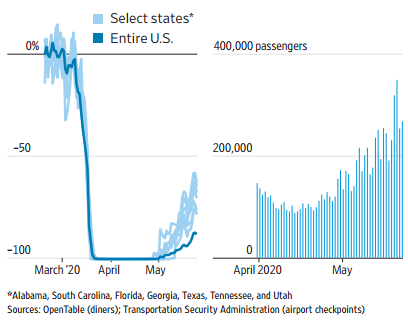BY HARRIET TORRY AND JOSH MITCHELL
MAY 26TH, 2020 FROM WSJ
Truck loads are growing again. Air travel and hotel bookings are up slightly. More people are applying to open new businesses.
These are among some early signs the U.S. economy is, ever so slowly, creeping back to life.

Plenty of data show the nation was still mired in a severe downturn in April and May, with overall business activity falling and layoffs rising— though more slowly than in the early weeks of the coronavirus crisis. Current projections have the U.S. economy contracting by 6% to 7% this year and unemployment lingering in double-digit percentages for a while.
But, for the first time since the pandemic forced widespread U.S. business closures in March, it appears conditions in some corners of the economy aren’t getting worse, and might even be improving.
“If this is the only wave [of coronavirus], it looks like we’ve bottomed out and the normalization process has begun,” said Beth Ann Bovino, U.S. chief economist at S&P Global Ratings.
Spending on hotels, restaurants, airlines and other industries hurt by social distancing remains low, but it appears to be picking up. The number of travelers passing through airport security-screening checkpoints totaled 87,534 on April 14, 96% below the same day a year earlier. But by Sunday, the figure had more than tripled to 267,451, although that is still down 87% from the same day a year earlier. Meanwhile, data from online restaurant-booking company OpenTable show diners are beginning to return in several states.
“We’re past the trough in terms of peak damage,” said
Gregory Daco, chief U.S. economist at Oxford Economics, with high-frequency indicators showing “a burgeoning rebound in terms of how much people are spending.”
“You can see that turn in the data, which is encouraging,” he said, “but you have to be cautious that we’re rebounding from extremely depressed levels.”
Indeed, the economic outlook remains highly uncertain. The latest hopeful signs coincide with a surge in emergency spending from Congress, a decline in the daily number of newly reported Covid-19 cases in the U.S. and the slow reopening of states—all factors that could prove temporary.
The effects of government aid such as enhanced unemployment benefits could ease in coming months. Federal Reserve officials warn conditions could deteriorate again if a second outbreak emerges as more people come out of their homes and return to a more normal life.
Much of the pickup in activity reflects states’ decisions to start opening up segments of their economies. This is expected to boost consumer spending, which accounts for about two-thirds of U.S. economic output.
But those prospects hinge on whether the businesses that cut millions of jobs since mid-March will be able to bring back workers.
People are likely to spend if they have steady paychecks and feel economically secure. Rehiring, in turn, will depend on how quickly states reopen, whether consumers feel comfortable venturing out and whether a second wave of the virus hits.
About 2.4 million people in the U.S. applied for first-time jobless benefits in the week through May 16, down from the record of nearly seven million who applied in the last week of March, Labor Department data show. The number of people receiving benefits in the week ended May 9—a proxy for overall levels of unemployment—increased to 25.1 million from 22.5 million a week earlier.
Job losses often persist for months after a recovery begins.
The 2007-09 recession ended in June 2009, according to the National Bureau of Economic Research. But the unemployment rate didn’t peak until months later, at 10% in October 2009, and remained above 9% for nearly another two years.
But for now, the nascent recovery can be seen in a number of industries. In shipping, while numbers remain low by historical standards, they suggest the carriers have turned a corner.
Truckstop.com, which measures demand in trucking’s spot market, said its weekly index has improved for four straight weeks and that available loads were up 27% in the week ended May 18.
DAT Solutions LLC, which matches freight shipments to available trucks, said its index for available loads rose 22% the week ended May 10 from the previous week.
Old Dominion Freight Line Inc., one of the largest truckers in the U.S., said its volumes fell sharply at the start of April, but Chief Executive Greg Gantt said in an earnings call that demand “has remained fairly steady since then.”
“We’d like to think that the worst is behind us,” Mr. Gantt said.
The beginning of April marked a trough for real-estate activity, according to Showing-Time, a real-estate software provider. With cities across the U.S. shut down, property showings were down nearly 50% in mid-April but picked up this month.
Showing activity, measured as a rolling weekly average in 100 top markets, was up 27% as of May 24, according to Showing-Time. Meanwhile, Mortgage Bankers Association data show a recent rebound in mortgage applications.
Justin Fichelson, a San Francisco real-estate agent, said activity has started improving.
“People have spent more time in their home than ever before,” he said. “People are realizing, ‘I need a great place to call home.’ ”
U.S. auto makers, meanwhile, resumed limited work at most of their factories last week, although they faced supply-chain disruptions. For economic activity overall, “we’re seeing some positive signals in household spending, in the real-estate market, and in the stock market,” said University of Chicago economist Constantine Yannelis, who worked in the Treasury Department during the Obama administration.
“But I don’t think we can predict whether those are going to continue and this is going to be a V-shaped recovery or this is going to be a sustained, prolonged depression. Really, the answer to that is going to come from the health situation.”
——Paul Page contributed to this article